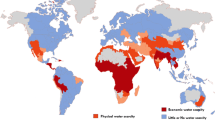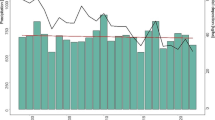Abstract
Water scarcity in arid and semi-arid regions is a great economic, environmental and social problem, where the people living in these regions have to use technologies, such as cistern, to ensure water for their survival. Given the difficulties in these regions, this paper aims to propose a methodology to estimate per capita water use for different levels of water shortage risk, ensuring water supply under the conditions of arid and semi-arid regions; and present a case study for the Brazilian semi-arid region. The methodology is based on analysis of spatial and temporal risks of water shortage in the cisterns. Analysis of the temporal risk of water shortage is based on the premise that the cistern is without water for 3 consecutive days with return periods of 5, 10 and 20 years. To ascertain the spatial risk of per capita water use associated with these return periods in hydrologically homogeneous regions, we evaluate the confidence interval associated with the average monthly water use. Thus, the proposed methodology allows to determine the potential water use in each homogeneous region. For the Brazilian semiarid region it is possible to identify the areas where local population has a greater restriction on the access to water (central semiarid region) and areas where there is greater water availability (north and south of the semi-arid). This variation of water availability allows to adapt management measures accounting for the ground conditions of each location, in order to meet the water needs of the local population.



Similar content being viewed by others
References
Amin MT, Tschung-il K, Amin MN, Han MY (2013) Effects of catchment, first-flush, storage conditions, and time on microbial quality in rainwater harvesting systems. Water Environ Res 85(12):2317–2319
ANA (2004) Projeto de gerenciamento integrado das atividades desenvolvidas em terra na bacia do São Francisco. Subprojeto 4.5C– Plano Decenal de Recursos Hídricos da Bacia Hidrográfica do Rio São Francisco -PBHSF (2004–2013). Nota técnica no 11: Programa de abastecimento da população rural da região semi-árida. Brasilia: ANA/GEF/PNUMA/OEA
ASA (2014) Semiárido. Articulação Semiárido Brasileiro. http://www.asabrasil.org.br/ Portal/Informacoes.asp?COD_MENU = 105. Accessed 08 April 2013
Baguma D, Loiskandl W (2010) Rainwater harvesting technologies and practises in rural Uganda: a case study. Water Resource Management 15:355–369
CGU (2011) Relatório de avaliação da execução de programas de governo n° 3: construção de cisternas para armazenamento de água. Controladoria-Geral da União, Brasilia
Cirilo JA (2008) Public water resources policy for the semi-arid region. Estudos Avançados 22(63):61–82
Cook S, Fengrui L, Huilan W (2000) Rainwater harvesting agriculture in Gansu Province, People’s Republic of China. J Soil Water Conserv 55(2):112–114
Department of Environmental and Aboriginal affairs Government of South Australia (1999) Rainwater tanks: their selection and maintenance
Domènech L, Saurí D (2011) A comparative appraisal of the use of rainwater harvesting in single and multifamily buildings of the Metropolitan Area of Barcelona (Spain): social experience, drinking water savings and economic costs. J Clean Prod 19:598–608
DTU (2000) Water Quality in Domestic Roofwater Harvesting Systems (DRWH). Domestic Roofwater Harvesting in the Humid Tropics – Report C3, Indian Institute of Technology, Centre for Rural Development and Appropriate Technology (RDAT), Hauzkhas, New Delhi. http://www2.warwick.ac.uk/fac/sci/eng/research/ dtu/pubs/reviewed/rwh/eu/c3.pdf. Accessed 05 February 2014
El-Sayed M, Mahgoub M, van der Steen NP, Abu-Zeid K, Vairavamoorthy K (2010) Towards sustainability in urban water: a life cycle analysis of the urban water system of Alexandria City. Egipt J Clean Prod 18:1100–1106
European Commission (2012) Commission staff working paper – impact assessment: a blueprint to safeguard Europe’s water resources. Brussels, 14.11.2012, SWD (2012) 382 final/2
FUNDAJ (2014) Semiárido: proposta de convivência com a seca. Fundação Joaquim Nabuco. http://www.fundaj.gov.br/index.php?option=com_content&view=article& id = 659&Itemid = 376. Accessed 05 February 2014
Garfì M, Ferrer-Martí L, Bonoli A, Tondelli S (2011) Multi-criteria analysis for improving strategic environmental assessment of water programmes. A case study in semi-arid region of Brazil. J Environ Manag 92:665–675
Gould J, Nissen-Petersen E (2003) Rainwater catchment systems for domestic supply – design, construction and implementation. ITDG Publishing, London
Howard G, Bartram (2003) Domestic water quantity, service, level and health. World Health Organization, Geneva
IRPAA (2009) Living harmoniously with the climate in the northeast of Brazil. Instituto Regional da Pequena Agropecuária Apropriada. http://www.irpaa.org. Accessed 05 April 2014
IRPAA (2014) Água no Semiárido Brasileiro. Instituto Regional da Pequena Agropecuária Apropriada. http://www.irpaa.org/ ebookbr/page6.htm. Accessed 05 April 2014
Ishaku HT, Majid MR, Johar F (2012) Rainwater harvesting: an alternative to safe water supply in Nigerian rural communities. Water Resource Management 26:295–305
Islam MM, Chou FNF, Kabir MR, Liaw CH (2010) Rainwater: a potential alternative source for scarce safe drinking and arsenic contaminated water in Bangladesh. Water Resource Management 24:3987–4008
Kahinda JM, Taigbenu AE, Boroto JR (2007) Domestic rainwater harvesting to improve water supply in rural South Africa. Phys Chem Earth 32:1050–1057
Khastagir A, Jayasuriya N (2007) Parameters influencing the selection of an optimal rainwater tank size: a case study for Melbourne. In: Proceedings of the Rain Water and Urban Design Conference 2007, Sydney, August 21–23 (in CD)
Khastagir A, Jayasuriya N (2010) Optimal sizing of rain water tanks for domestic water conservation. J Hydrol 381:181–188
Kite GW (1988) Frequency and risk analyses in hydrology, 5th edn. Water Resources Publications, Highlands Ranch, Colorado
Krishna H, Brown C, Gerston J, Colley S (2005) The Texas manual on rainwater harvesting, 3rd edn. Texas Water Development Board, Austin
Kus B, Kandasamy J, Vigneswaran S, Shon HK (2010) Analysis of first flush to improve the water quality in rainwater tanks. Water Sci Technol 61(2):421–8
Lancaster B (2006) Rainwater harvesting for dry lands, vol. 1, Appendix 3. http://www.harvestingrainwater.com/wp-content/uploads/Appendix3Calculationspdf
Leavitt M, Teagu, J (2014) Topic synopses: world health organization. LVMUN I 1st Annual Las Vegas Model UN Conference, February 22, 2014. http://www.svhsmun.net/uploads/2/3/7/1/23711266/lvmun_i_who.pdf
Malagnoux M, Sène EH, Atzmon N (2007) Forests, trees and water in arid lands: a delicate balance. Unasylva 229(58):24–25
MI (2005) The new delimitation of semi-arid Brazil Brasilia, Brazil (in Portuguese). Ministry of National Integration of Brazil. http://www.mi.gov.br
MI (2014) “Water for All” program. Ministry of national integration of Brazil http://www.integracao.gov.br/agua-para-todos
Prinz D (1996) Water harvesting: past and future. In: Pereira LS (ed) Sustainability of irrigated agriculture. In: proceedings of the NATO advanced research workshop. NATO, Balkema, Rotterdam, pp 135–144
Rodriguez RDG, Singh VP, Pruski FF (2015) Using entropy theory to improve the definition of homogeneous regions in the semi-arid region of Brazil. Hydrol Sci J. doi:10.1080/02626667.2015.1083651
Scanlon BR, Keese KW, Flint AL, Flint LE, Gaye CB, Edmunds WM, Simmers I (2006) Global synthesis of groundwater recharge in semiarid and arid regions. Hydrol Process 20:3335–3370
SCSC, NWRI (2008) Why is soil salinity of concern in arid and semi-arid regions? Southern California Salinity Coalition and National Water Research Institute. http://www.salinitymanagement.org/Salinity%20Management%20Guide/lz/lz_2.html
Souza SHB, Montenegro SMGL, Santos SM, Pessoa SGS (2011) Avaliação da Qualidade da Água e da Eficácia de Barreiras Sanitárias em Sistemas para Aproveitamento de Águas de Chuva. Rev Bras Recur Hidr 16(3):81–93
Thomas T (2010) Domestic water supply using rainwater Harvesting. http://www.tandfonline.com/loi/rbri20
UNESCO (1999) World water resources at the beginning of the 21st century. http://webworld.unesco.org/water/ihp/db/shiklomanov/summary/html/summary.html
Williams WD (1999) Salinisation: a major threat to water resources in the arid and semi-arid regions of the world. Lakes Reserv Res Manag 4:85–91
Xu ZX, Ito K, Liao S, Wng L (1997) Incorporating inflow uncertainty into risk assessment for reservoir operation. Stoch Hydrol Hydraul 11:433–448
Zaide M (2007) Drought and arid land water management. CSD-16/17 National Report Israel
Acknowledgments
The authors acknowledge the support by the CAPES Foundation, Ministry of Education of Brazil, under Grant number BEX 9508/13-9.
Author information
Authors and Affiliations
Corresponding author
Rights and permissions
About this article
Cite this article
Rodriguez, R.D.G., Pruski, F.F. & Singh, V.P. Estimated Per Capita Water Usage Associated with Different Levels of Water Scarcity Risk in Arid and Semiarid Regions. Water Resour Manage 30, 1311–1324 (2016). https://doi.org/10.1007/s11269-016-1236-7
Received:
Accepted:
Published:
Issue Date:
DOI: https://doi.org/10.1007/s11269-016-1236-7




